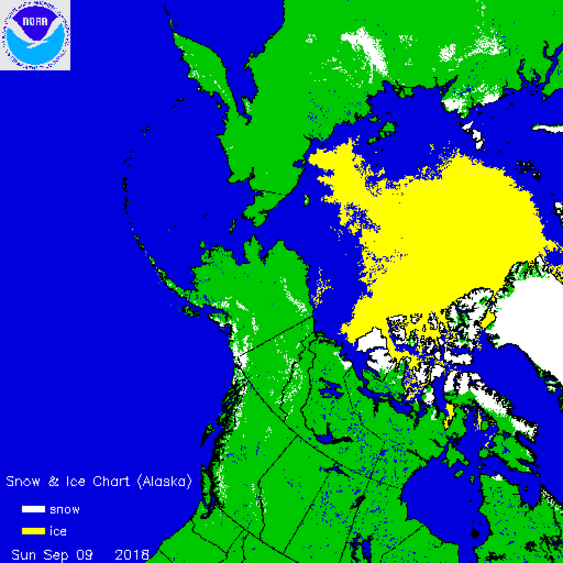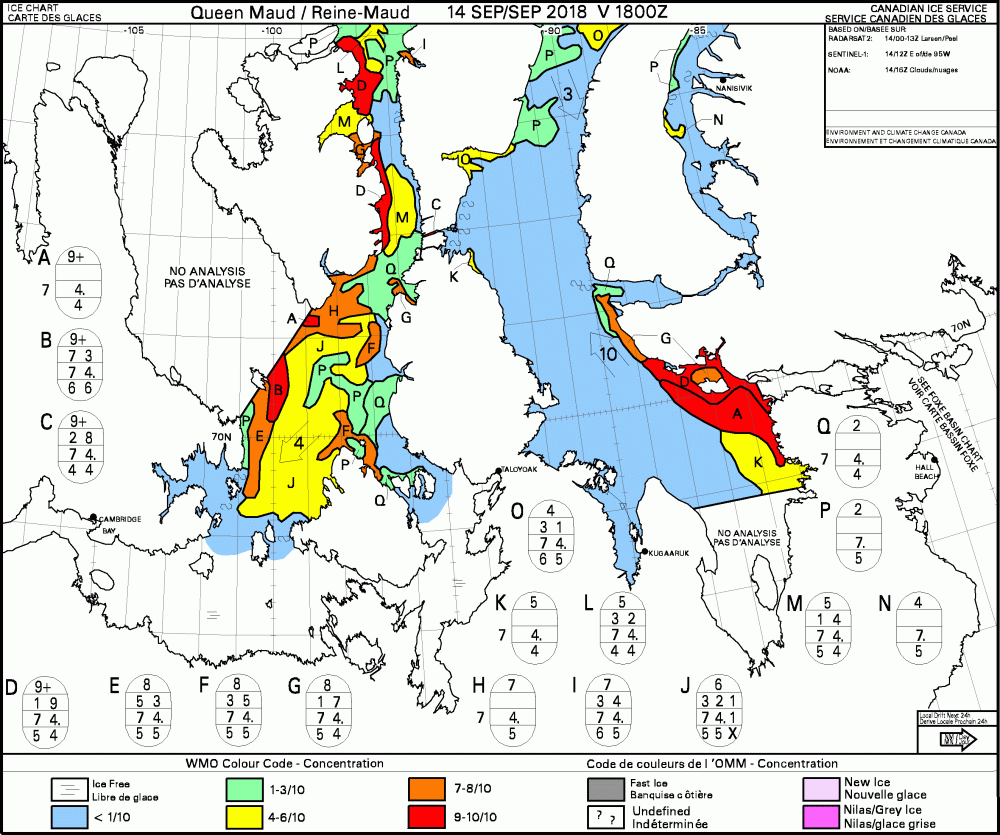
October Update: Full September 2018 Results

More details at Try to Remember: There’s Ice in September
One week ago on day 252 MASIE reported the lowest daily extent of the year at 4.43M km2. One week later the image above shows how the ice edges have refrozen and extended. Note also the significant snowfall both in Canada and Russia
Mid September we can see the long predicted collapse of Arctic ice is postponed for yet another year. The graph shows MASIE reporting ice extents above 4.5M km2 for the month of September. A dip on day 252 to 4.43M km2 will likely be the daily minimum for the year, since 200k km2 of ice has been added in the last week. The graph also shows that 2018 is presently 96k km2 above the 11 year average ice extent, 350k km2 more than 2016, 472k km2 more than 2007, and 1.2M km2 (a full Wadham!) more than the record setting 2012.

Interestingly, in September until yesterday NOAA’s officially referenced Sea Ice Index (SII) was showing more ice than MASIE, by about 200k km2. That means the SII September monthly result will continue the plateau in Arctic ice since 2007.

The table below shows ice extents in the various basins comprising the Arctic Ocean for day 259 for 2018 and 2007 in comparison to the 11 year averages (2007 to 2017 inclusive).
| Region | 2018259 | Day 259 Average |
2018-Ave. | 2007259 | 2018-2007 |
| (0) Northern_Hemisphere | 4622484 | 4526053 | 96431 | 4150314 | 472171 |
| (1) Beaufort_Sea | 560233 | 471483 | 88750 | 515813 | 44420 |
| (2) Chukchi_Sea | 163790 | 150187 | 13604 | 48053 | 115737 |
| (3) East_Siberian_Sea | 467586 | 270891 | 196695 | 311 | 467275 |
| (4) Laptev_Sea | 27262 | 140510 | -113248 | 238846 | -211584 |
| (5) Kara_Sea | 235 | 23504 | -23268 | 52498 | -52263 |
| (6) Barents_Sea | 0 | 23798 | -23798 | 7420 | -7420 |
| (7) Greenland_Sea | 83223 | 203153 | -119930 | 329643 | -246420 |
| (8) Baffin_Bay_Gulf_of_St._Lawrence | 40128 | 29596 | 10532 | 32287 | 7841 |
| (9) Canadian_Archipelago | 346993 | 274872 | 72121 | 237669 | 109324 |
| (10) Hudson_Bay | 6051 | 7085 | -1034 | 4355 | 1697 |
| (11) Central_Arctic | 2926584 | 2929894 | -3309 | 2682144 | 244440 |
Presently, 2018 is about 100k km2 or 2% above average, and 472k km2 or 11% more than 2007. The Eastern Arctic shows surpluses in East Siberian, Chukchi, Beaufort, and CAA. The Western Arctic shows deficits in Laptev, Kara, Barents and Greenland seas. The Central Arctic is matching average, while East Siberian sea ice is 73% above average.
As reported previously, the Northwest Passage through Nunavut was closed this year due to excessive and thick multiyear ice blocking the way. The chart below shows the conditions as of Sept. 14.

It won’t get any better than this for yachts attempting the passage west, since more than 3/10 (green) ice conditions blocks their progress. A post at the Northwest Passage blog S/V CRYSTAL Escape from Prince Regent Inlet explains how the passage is closing.

Breaking through the ice corridor, already close to the shore, we suddenly saw something unusual. Static ice so far began to flow very rapidly towards the shore! In this way he closed the road ahead of us and – which is much worse – cut off our retreat. We turned back and rushed to escape. It was the only option.
We drove the gas to the top, and the free water in front of the bow disappeared in her eyes . Giant ice floes moved towards the shore like in a river stream. We jumped out of some of the channels with maybe a meter of side wall, and the path behind us disappeared after a few dozen seconds.
After about thirty minutes of such a crazy slalom we got to the water so slow that the danger of being closed and pressed to the shore was averted . That was good news for us. The bad news was that this time we were unable to get out of Prince Regent Inlet. It was waiting for the next chance . (note: the log is translated from Polish)
Update September 19, 2018
Here is the latest ice chart showing that in Franklin strait, all the green conditions (<3/10) are now gone, while red and brown are taking over.

Bottom line: They succeeded to get out and are now docked on Greenland coast.

Reblogged this on Climate Collections.
LikeLike
Ron,
It will be very interesting what the new NASA satalite records. It will make interesting comparisons.
LikeLike
Reblogged this on 4TimesAYear's Blog.
LikeLike